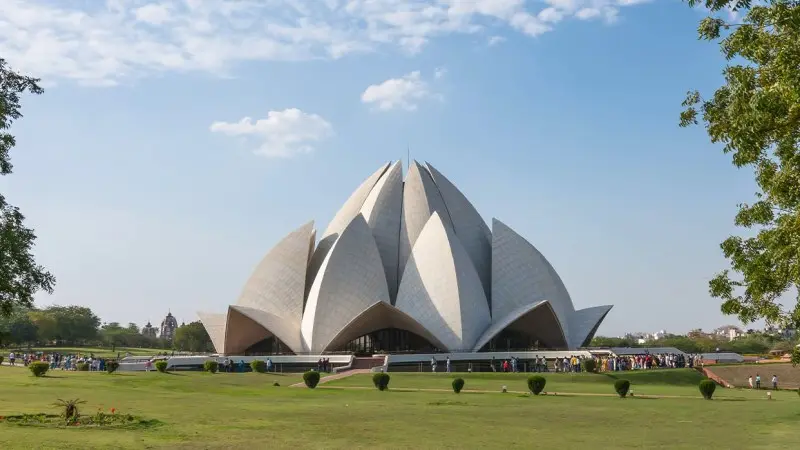Nestled in New Delhi, India, the Lotus Temple, also known as the Bahá’í House of Worship, stands as a captivating architectural gem. Renowned for its exquisite lotus flower-inspired design, this magnificent structure attracts millions of visitors annually.
This article will explore the reasons why a visit to the Lotus Temple is a must, delve into its location and route, highlight the best time to visit, and showcase the captivating sights awaiting exploration within its serene premises.
Why Visit the Lotus Temple?
The Lotus Temple offers a serene sanctuary for individuals seeking solace, tranquility, and a profound connection with their inner selves. Here are compelling reasons why a visit to this awe-inspiring monument is highly recommended:
1. Architectural Wonder
The Lotus Temple’s design is a feast for the eyes. Resembling a resplendent lotus flower in full bloom, the temple seamlessly merges modern architecture with spiritual symbolism. Its elegant structure, accompanied by immaculate gardens, creates a harmonious ambiance that leaves visitors in awe.
2. Spiritual Significance
As a sacred place of worship for followers of the Bahá’í faith, the Lotus Temple embodies core principles such as unity, equality, and harmony among all religions. Visitors from diverse religious backgrounds are warmly welcomed to immerse themselves in the temple’s tranquil atmosphere, engage in meditation, or reflect upon profound aspects of life.
3. Peaceful Atmosphere
The temple’s serene surroundings provide an escape from the bustling city life of New Delhi. The absence of religious rituals and idols fosters a universal sense of peace and inclusivity, enabling visitors to find solace and engage in quiet contemplation.
Location and Route
The Lotus Temple is situated in the southern part of New Delhi, specifically in the Bahapur neighborhood, near Nehru Place. Here’s how you can reach the temple with ease:
1. By Air
The closest major airport to the Lotus Temple is the Indira Gandhi International Airport. From there, you can conveniently hire a taxi or take the Delhi Metro to reach the temple.
2. By Train
The Hazrat Nizamuddin Railway Station, located approximately 9 kilometers away, is the nearest railway station to the Lotus Temple. From the station, taxis or auto-rickshaws are readily available for a short journey to the temple.
3. By Metro
The Nehru Place metro station, situated on the Violet Line, is the closest metro station to the Lotus Temple. After reaching Nehru Place, you can hire a rickshaw or taxi for a brief ride to the temple.
When to Visit
The Lotus Temple welcomes visitors throughout the year, except on Mondays when it remains closed. However, the best time to visit is during the autumn and winter months, from October to March. The weather during this period is pleasant, facilitating comfortable exploration of the temple’s gardens and providing an ideal environment for moments of quiet contemplation.
What to See
Upon arriving at the Lotus Temple, visitors are greeted by sprawling manicured gardens and picturesque pathways. Here are some notable attractions within the temple complex:
1. Main Prayer Hall
The central prayer hall serves as the focal point of the Lotus Temple and can accommodate approximately 2,500 people. Its striking design, featuring a dome composed of 27 petal-like structures, showcases the architectural brilliance and aesthetic allure of the temple.
2. Meditation Rooms
The Lotus Temple offers dedicated meditation rooms where visitors can immerse themselves in tranquility and engage in silent contemplation. The serene atmosphere within these rooms enhances the spiritual experience, providing individuals with an opportunity to find inner peace.
3. Information Centre
Within the temple complex, an information center is available for visitors to delve deeper into the principles of the Bahá’í faith, learn about the temple’s construction, and understand its significance as a place of worship and unity.
4. Gardens and Ponds
Meticulously maintained gardens surrounding the Lotus Temple provide a picturesque setting for leisurely walks, photography, and moments of quiet reflection. The tranquil ponds add to the overall ambiance, offering a soothing backdrop that complements the temple’s splendid architecture.
Conclusion
The Lotus Temple stands as a symbol of unity, spirituality, and architectural grandeur. With its remarkable lotus-inspired design, serene atmosphere, and tranquil surroundings, this architectural marvel appeals to visitors from all walks of life.
Whether seeking solace, appreciating remarkable architecture, or desiring a serene space for introspection, a visit to the Lotus Temple in New Delhi promises an enriching experience that fosters a deep sense of peace and connection.







